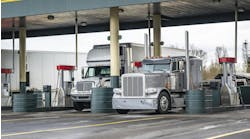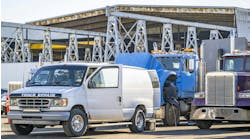Truck drivers work hard and want to get paid well for it. But often their pay structure is very complex: base pay plus accessorial fees plus company bonuses and so on. And is the base pay based on mileage, loads, or hours? The complexity of a truck drivers pay is not easy to manage. Some of the most common types of pay are:
- Pay per hour: Indeed says the average pay for truck drivers per hour is $19.92.
- Revenue share: Pay based on the percentage of the load.
- Pay per mile: Average OTR driver pay is between 44 and 58 cents per mile with drivers completing around 3000 miles per week. Regional truck drivers make between 37 and 55 cents per mile for an average of up to 2800 miles per week. Company team drivers make 48–75 cents per mile with up to 6000 miles per week on average. Owner-Operator drivers get paid 94 cents to $1.79 per mile for an average of 3000 miles per week.
Accessorial fees, such as loading/unloading, detention time, and stop-offs, may be reimbursed. Bonuses can be added to pay as well. These include sign-on bonuses, referral bonuses, and safety and fuel management bonuses. On top of all of these are benefits for health and medical and other company perks.
Owner-operators, who own and operate their own truck, make between $100,000 and $150,000 per year gross, with top earners making over $300,000. However, of this amount, expenses can run as high as seventy percent, thus the average net pay equates to between $50,000 and $60,000, or in the case of top earner, over $100,000.
Truck drivers who do ice road, hazmat, and oversized load hauling make more money than average truck drivers do. Other high-paying truck jobs include team drivers, owner-operators, and private fleets.
Driver settlement
Often there is much finger-pointing when it comes to settlement because the shipper pays the carrier (or 3PL), who then pays their truck driver or contracted independent owner-operator. Because of so many touches, issues with invoicing and payments arise that can short-change the truck driver.
For example, the shipper claims to make a payment, but the invoice is off by $100. The carrier will have to follow up to get the correct payment. However, suppose the carrier doesn’t notice the shortfall, and the payment goes directly to the truck driver. In that case, the trucker may not know exactly who to contact about the discrepancy.
Technology can help by creating rate plans for drivers that incorporate the base pay, accessorial fees, surcharges, and bonuses. Trucks equipped with electronic logging devices (ELDs) send trip data into the settlement solution that combines the driver’s rate plan with the data to calculate pay. No more managing multiple spreadsheets and having to re-enter data into the system.
Factoring makes pay quicker
Factoring is the process of selling freight invoices to a factoring company for a cash advance up to 98%. Instead of waiting 30, 60, or 90 days for a load to be paid out, factoring companies will pay the money to the truck driver for a service fee.
Freight factoring financially benefits owner operators, helping them to have a continuous flow of cash. With the average payout for a load delivery being over 40 days, many trucking companies have struggled making ends meet. With freight factoring, a factoring company buys the invoice for slightly less than the total owed, but the invoice is paid immediately. No more waiting weeks for money to come in. Small trucking firms and owner operators can cover their expenses without incurring any further debt.
Freight factoring has been growing in popularity as the trucking industry deals with issues like the driver shortage, higher cost of hauling freight, and the global economy. By integrating factoring into a TMS, small to medium-sized carriers can improve cash flow and save time with accounting processes. Factoring helps carriers and OOs maintain a consistent cash flow with quicker payments, allowing the drivers to haul more loads.



